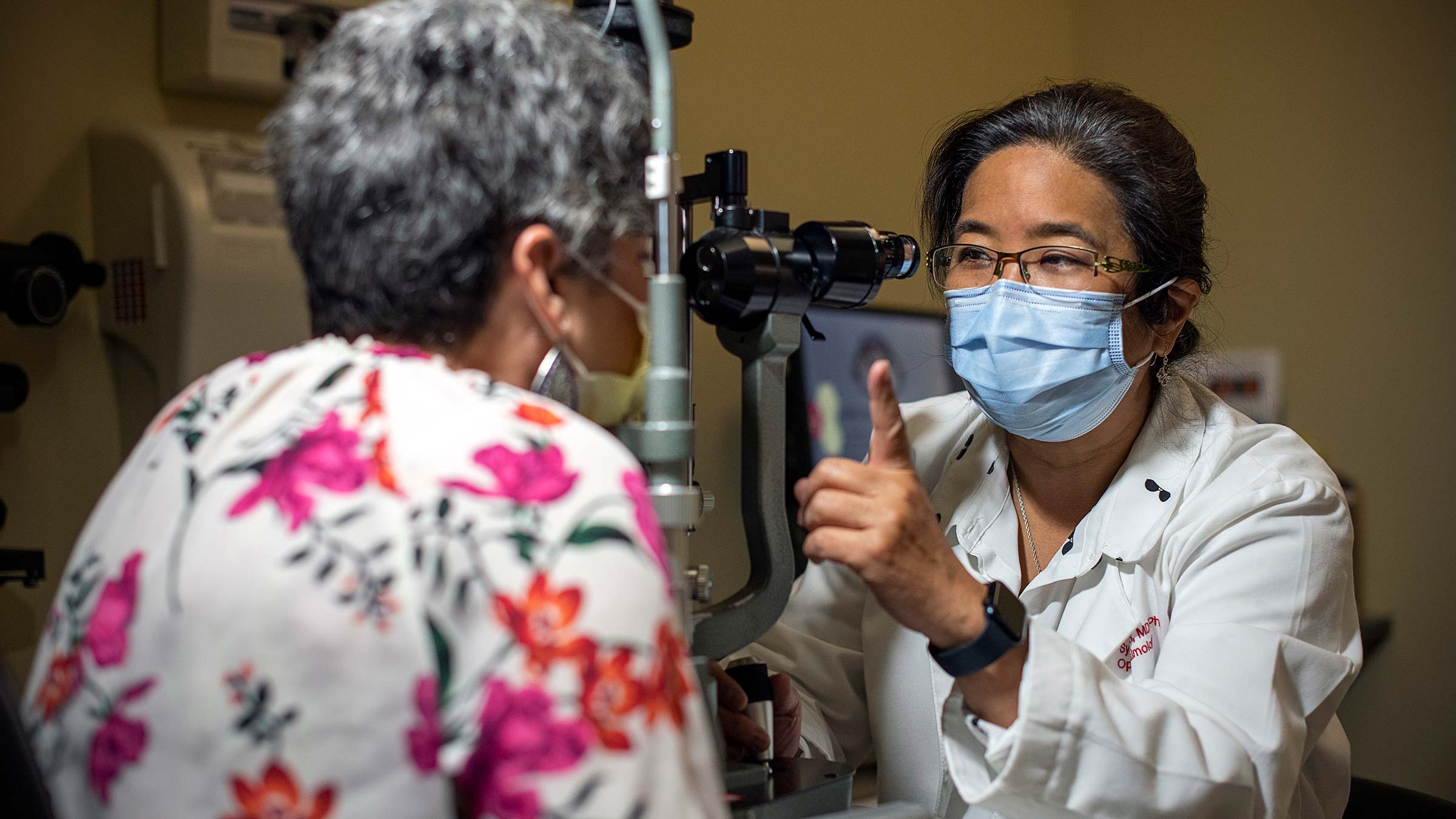
Health disparities are driven by many factors — access to high-quality health care and education; neighborhood, social and community culture; and economic stability — and these factors do have consequences on eye health. For glaucoma specialist Sayoko Moroi, MD, PhD, those disparities come into sharp focus when she peers into the eyes of some of her most vulnerable patients.
Many eye conditions that cause blindness are more prevalent among certain populations. Addressing inequities has long been a motivation for Dr. Moroi, and it’s a priority for the Department of Ophthalmology and Visual Sciences that she chairs at The Ohio State University College of Medicine.
Minorities are some of the most affected by glaucoma. For example, a 20-year follow-up of 1,636 patients with ocular hypertension, or high eye pressures, published in April 2021 showed that the rate of developing glaucoma was 55% among Black participants, but 43% among participants of other races.
“The question is ‘why?’ — and it’s complex, and multifactorial — and then, ‘what can we do about it?’ Certainly, it’s a challenge and continual motivation for me: What can I do as a single clinician to impact that?” says Dr. Moroi, who holds the William H. Havener, MD, Chair in Ophthalmology Research at the Ohio State College of Medicine and directs the Havener Eye Institute.
Dr. Moroi aspires to foster greater impact through community medicine partnerships with innovative camera-based technologies to improve access for certain groups in need of eye health services. With appropriate use of teleophthalmology, a form of telemedicine, patients have access to select screening services locally through their primary care providers. With proper eye equipment and communication between ophthalmologists or optometrists and primary care partners, patients benefit from earlier diagnoses.
“After a ‘positive screen’ through teleophthalmology for an eye condition, then we need to educate and ensure that the individual patient can follow through with an in-person visit to the ophthalmologist,” Dr. Moroi says.
This program began with retina specialist Matthew Ohr, MD, who’s made inroads to implement and grow diabetic retinopathy screenings in underserved areas, such as small rural communities, through telemedicine. Recently, he’s implemented a teleretina screening program focused on sickle cell retinopathy.
In addition, Dr. Ohr and Dr. Moroi are working with The Ohio State University Wexner Medical Center leadership to partner with Federally Qualified Health Centers (FQHCs), which receive federal funds to provide primary care to underserved populations. The partnership launched with vision screenings and provision of eyeglasses in October 2022, and will build upon Dr. Ohr’s earlier success with teleretina screening using a camera to provide diabetic retinopathy and glaucoma screenings.
“This is how we want to impact health care disparities,” Dr. Moroi says, “by going above and beyond to figure out how to make access convenient for the patient.” Sayoko Moroi, MD, PhD
Dr. Moroi’s support has been invaluable in taking these sustainable, technology-based solutions to patients to address health disparities, Dr. Ohr says.
“By leveraging this technology, we are able to bring this resource to patients rather than requiring that they come to us,” he says. “The program has since expanded into a federal grant that supports exploring the best practices for sustaining this service in the future for patients with the greatest need.”
Eventually, Dr. Moroi would like eye screening through teleophthalmology to be incorporated into annual physicals, preventing patients from having to take additional time off work, making an additional appointment and arranging transportation. Anytime a patient screening reveals an eye disease, an automatic referral would be made to a specific specialist to make accessing the additional care as convenient as possible.
Dr. Moroi’s passion for addressing disparities has driven her to become a certified facilitator of implicit bias training at the Ohio State Wexner Medical Center and College of Medicine.
Implicit, or unconscious, biases are those that we carry without being aware of them due to our individual experiences and the culture around us. Without our realization, such biases can affect the way certain populations are treated across many aspects of society, including health care and education.
Implicit bias training focuses on raising awareness and self-awareness about those biases and on ways to help counteract them.
Dr. Moroi co-facilitates training whenever her schedule allows. In recent months, she’s presented classes to emergency medicine residents and first- and second-year medical students. She says the challenge is to make the course real and personal. Throughout the course, those taking the training become more engaged, and each is asked to make an anonymous pledge to try to personally do something to mitigate their own biases in the health care arena.
“I got a standing ovation from the second-year medical students,” she says. “The feedback has been very, very positive.”
To further help reduce biases, as well as to bring a wide range of talent to Ohio State, Dr. Moroi strives to have diverse faculty members care for those who wish to be seen by someone who looks like them or is from the same region. To remind herself of ensuring diversity, she keeps near her desk a corkboard map with pushpins that faculty place to represent their training sites.
“I think it’s very important that we continue the self-learning education journey. We need to create and foster a diverse workforce and mentor diverse leaders. We must have conversations about biases so that we can be more self-aware to create health care excellence,” Dr. Moroi says.

Ready to learn more about eye care?
Ohio State's ophthalmology team provides comprehensive care backed by one of the nation's leading academic health centers.
Expert care starts here



